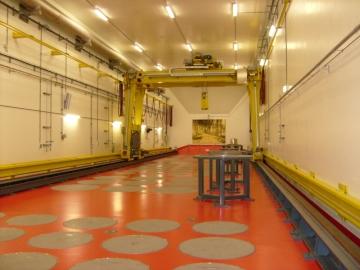
Section Branding
Header Content
Savannah River Site Debuts New Green Power Plant
Primary Content

Wood chips and old shredded tires could save the federal government around $1 billion over the next two decades, according to officials at the Savannah River Site in South Carolina.
The nuclear science site near Aiken has opened a new power plant that burns the waste material to make steam, which in turn generates enough power to run 30 percent of plant operations, the Department of Energy said.
The plant, designed and operated by Ameresco Inc., has been fully operating since the beginning of the month. On Monday, dozens of officials from the Massachusetts-based company came south for the official ribbon cutting of the Biomass Cogeneration Facility.
The federal government paid Ameresco $795 million for a 20-year contract for the plant, which Energy Department officials said is by far the biggest renewable energy contract signed by the federal government. In return, Ameresco promised $944 million in savings from the biomass plant, which replaces a coal-fired plant built around the same time that the plant started cranking out nuclear bombs during the Cold War arms race with the Soviets in the 1950s.
"We're going to get guaranteed savings. That's a tremendous thing to say. And clean air too," said Thomas D'Agostino, undersecretary for nuclear security for the Energy Department.
Officials estimate the new power plant will remove 100,000 tons of polluting greenhouse gases from the air every year.
It took 30 months to build the plant. A pair of 60-foot-tall mountains of wood chips dominate the landscape. The wood and shredded tires are burned at temperatures of up to 1,700 degrees to create steam in two massive boilers. The steam operates turbines that provide about 30 percent of the roughly 40 megawatts of power that the site uses each year. It also provides all the steam for heating and cleaning for the site, which has been transformed from making nuclear bombs to a three-pronged mission of protecting national security, providing cleaner sources of energy including nuclear power, and helping the nation store radioactive material used in nuclear bombs and power plants.
"This isn't nuclear. It doesn't build on our nuclear experience. But it is equally important," said David Moody, manager of the Department of Energy's Savannah River Operations Office.
The plant is designed to last for more than 40 years, so once the contract with Ameresco is over, the federal government will get to pocket all the savings. Moody said.
Also, if the energy savings aren't what Ameresco projected, the company agreed to take the loss.
"It's not like all the other federally funded projects out here that can go to Congress and ask (for) a couple more million dollars," said Ken Chacey, site manager for Ameresco.
One of the main roles for the new biomass power plant is to provide power for the site's new mixed-oxide fuel program, which officials hope to open in 2016. That plant will take the tritium in old nuclear bombs and covert it to be used to power nuclear power plants.
"When you think about the recycling that is helping recycling, it can make your head spin," D'Agostino said.
Ameresco buys wood chips left over from mills and shredded tries from plants within 50 miles of the site — any further would involve so much fuel to get them to the site that it wouldn't make sense for a green plant, company officials said.
The trucks that bring in those wood chips provided the visual of the day for the ribbon cutting. A truck backs into a long platform connected to a giant blue bin. The entire truck is tilted 60 degrees, dumping the wood chips inside.
The process takes less than five minutes, as soon as the driver gets out of the cab and onto the concrete driveway.
"They learn to take their coffee out too," Energy Department spokesman Bill Taylor said.
Tags: Savannah River Site, Green Power Plant, nuclear science site
